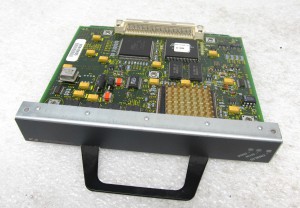So continuing from where I left off, I thought I’d setup a small Netware network onto my GNS3 testbed.
Netware was once the big dog in the networking world, but now it’s just a footnote in obscurity. Â Long gone are the days of syscon, rconsole, and all the frametypes that Netwaer supported in equally incompatible ways. Â So maybe it’s a good thing.
But I digress, years ago I paid good money for a 50 user version of Netware 3.12. Â I don’t know why either, but I occasionally like to get it running so I don’t feel like I completely wasted the thing.
With the right lan drivers, installation is a snap. Â Or if you don’t have the right lan drivers, create a MS-DOS VM, so it’ll have an IDE hard disk. Â You can install netware without lan drivers just fine. Â I just installed netware by itself, then added in some patches for the network card & the idle program so it wouldn’t eat 100% of my CPU. Â For the network though the command line was a little weird but I worked it out
file server name vmware
ipx internal net 538787d
mount all
load c:\server.312\nw4-idle.nlm
load c:\server.312\pcntnw slot=10001 FRAME=Ethernet_802.2
BIND IPX to pcntnw NET=cab2
load remote password
load rspx
Which gets me networking, and rconsole support. Â With the server running, I just then had to enable IPX routing on my cisco routers.
R1
ipx routing ca00.1b00.0008
interface FastEthernet0/1
ipx encapsulation SAP
ipx network CAB1
interface Serial1/0
mtu 2000
ipx network CAB0
R2
ipx routing ca08.140c.0008
interface FastEthernet0/1
ipx encapsulation SAP
ipx network CAB2
interface Serial1/0
mtu 2000
ipx network CAB0
 Now with this all in place I can see the IPX routes from R1, including the one that goes directly into the server:
R1#show ipx route
Codes: C – Connected primary network, c – Connected secondary network
S – Static, F – Floating static, L – Local (internal), W – IPXWAN
R – RIP, E – EIGRP, X – External, A – Aggregate
s – seconds, u – uses, U – Per-user static/Unknown, H – Hold-down4 Total IPX routes. Up to 1 parallel paths and 16 hops allowed.
No default route known.
C CAB0 (HDLC), Se1/0
C CAB1 (SAP), Fa0/1
R CAB2 [07/01] via CAB0.ca08.140c.0008, 56s, Se1/0
R 5383787D [08/02] via CAB0.ca08.140c.0008, 56s, Se1/0
And of course I can see the server!
R1#show ipx servers
Codes: S – Static, P – Periodic, E – EIGRP, H – Holddown, + = detail
U – Per-user static
2 Total IPX ServersTable ordering is based on routing and server info
Type Name Net Address Port Route Hops Itf
P 4 VMWARE 5383787D.0000.0000.0001:0451 8/02 2 Se1/0
P 107 VMWARE 5383787D.0000.0000.0001:8104 8/02 3 Se1/0
Now if you remember from the bad old days of Netware, each service running on a server is advertised. Â So in this case, type 4 is a file/print server, and 107 is a server running the ‘remote’ facility so you can rconsole into it.
Another thing to take note, is that because I configured IPX on serial interfaces is that their encapsulation is always HDLC. Â Also because IPX cannot fragment like TCP/IP the MTU on the serial interface *MUST* be larger than ethernet’s 1500. Â I like 2000 as I avoid all frame overhead this way.
Now I’m using the old netware client with the drivers I found here, and it works fine, as long as I had the MTU bumped up on the serial interface. Â Now I could have used ethernet, and it’d achieve the same thing, except I’m not in some weird MTU war.
At the same time, it is very slow.  If you want to do anything reasonably fast, you really need to move your client to the same VNet as the server.  But if you want to feel like the old days when connections were slow, well you’ll enjoy a max 400k connection.  I tried enabling stacker compression on the interface, but it resulted in packet corruption.  I think it’s an IOS thing though, so if you play with this, you may have better luck.  Back before MPLS was everyone’s latest wan joy, I ran stacker compression, and the speed boost was really noticeable, with a 1.5:1 or 2:1 compression not being uncommon.  Although on lower routers it could be a killer (the 2500…) or a 7000 with multiple interfaces doing compression it could also bring a router to it’s knees.  Also looking at the support table for the  SA-COMP/1  SA-COMP/4 I doubt 12.4 would support stacker compression properly.
[table id=2 /]
Otherwise, yeah it works fine. Â I also loaded up a Windows NT client, and it works too!



Hi I am trying to install Netware 4.11 in vmware but I am struggling to find a Licence Disk for it (and because of that I can’t install it) for some reason this disk is nowhere to be found on the internet so I am stuck now and don’t know what to do so if you maybe know where I can find at least 10 user licence for Netware 4 let me know
Thanks for Anwsering and Best Regards
The only copy I had was the 2 user Dev version for OS/2. Honestly it was too little too late back then, OS/2+NetWare was horrible compared to NT.
Hi can share your version?
Would like to build a collection of them
PS: if you could also share your Licence Disk for Netware 3.12 I wuld be realy happy (would like to try it with GNS3)